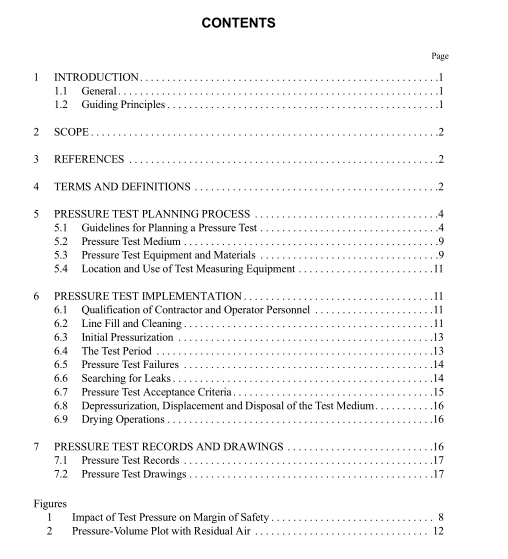API RP 1110 pdf download

API RP 1110 pdf download Pressure Testing of Steel Pipelines for the Transportation of Gas, Petroleum Gas, Hazardous Liquids, Highly Volatile Liquids or Carbon Dioxide
4.14 feature:Any physical object detccted by an in-line inspection device.Features may be anomalies, components, ncarbymetallic objocts, or some other item.
4.15 freeze plug: A pipeline isolation point created by freezing hydrostatic test water inside the pipeline by the application ofliquid nitrogen to the outer surface of the pipe.Normally used to separate a test section into smaller test segments in order to iden-tify leaks more readily or used to establish a test boundary.
4.16 gas: Natural gas,flammable gas or gas which is toxic or carosive.
4.17gouge:Elongated grooves or cavities caused by mechanical removal of metal.4.18hazardous liquid: Petroleum, petroleum products or anhydrous ammonia.
4.19 highly volatile liquid: A hazardous liquid which forms a vapor cloud when released to the atmosphere and has a vaporpressure excceding 40 psia(276 kPa) at 100°F(37.8°CY.
4.20inspection: The use of a nondestructive testing technique.
4.21leak test: A pipeline test designed to determine the presence or absence of leaks in a pipeline system. A leak test can beused alone or in addition to a spike pressure test andor a strength pressure test as required by the pressure testing plan.
4.22 Nondestructive Testing (NDT): A process that involves the inspection, testing or evaluation of materials, componentsand assemblis for materials’ discontinuities, properties and machine problems without further impairing or destroying the part’sserviccability.
4.23operating pressure: The actual steady-state pressure at a discrete point within a pipeline system at a specific time.4.24 operating pressure limit: A generic term used to describe the upper end of the operating pressure range of a pipeline.ln international codes and standards, it is often refrred to as the Maximum Steady State Operating Pressure (seec ASMEB31.4—2002, Section 400.2) or Maximum Allowable Operating Pressure (see ASME B31.8—2003, Section 805.214).4.25operator: A person or organization that operates pipeline facilities.
4.26 petroleum: Crude oil, condensate, natural gasoline, natural gas liquids, and liquefied petroleum gas.
4.27 petroleum gas: Propane, propylene, butane (normal butane or isobutanes), and butylenes (including isomers), or mix-tures composed predominantly of these gascs, having a vapor pressure not cxceeding 208 psig (1,434 kPa) at 100F(37.8℃C).4.28petroleum products: Flammable, toxic, or corrosive products obtained from distilling and processing of crude oil,unfinished oils, natural gas liquids, blend stocks and other miscellaneous hydrocarbon compounds.
4.29pipeline: A continuous part of a pipeline facility used to transport a gas, petroleum gas, hazardous liquids, highly volatileliquids or carbon dioxide. Includes pipe, valves, and other appurtenances attached to pipe.
4.30pipeline system: All portions of the physical facilities through which gas, petroleum gas, hazardous liquids, highly vol-atile liquids or carbon dioxide moves during transportation.This includes pipe, valves, and other appurtenances attached to thepipe, compressor units, pumping units, metering stations, regulator stations, delivery stations, breakout tanks, holders, and otherfabricated assemblies.
4.31pressure reversal: A phenomenon whereby a pipeline segments fails at progressively lower test pressures during sub-sequent pressure tests.
4.32qualification (personnel): The process of demonstrating skill and knowledge, along with documented training andexperience required for personnel to properly perform the duties of a specific job.
4.33seam: The longitudinal or spiral weld in fabricated line pipe.
4.34service provider: Any organization or individual providing scrvices to operators.4.35shall: The term“shall” is used to indicate those practices that are mandatory.
4.36should: The terms “should” or ” it is recommended” are used to indicate that a provision is not mandatory but recom-mended as good practice.
5 Pressure Test Planning Process 5.1 GUIDELINES FOR PLANNING A PRESSURE TEST Pipeline systems are pressure tested to demonstrate their fitness for service under intended operating conditions. Tests may be conducted prior to placing newly constructed pipelines into service; to revalidate historical operating conditions as part of an integrity assessment process; to verify the integrity of a pipeline before returning it to service after being idle or inactive; and to establish the pipeline’s ability for modified operations such as operating at higher operating pressures or transportation of differ- ent products.









